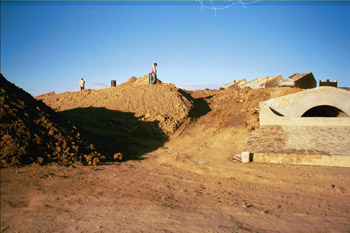earth-sheltered homes: soil and groundwater

Since earth-sheltered housing usually requires a heavier structure and may be placed more deeply into the earth than a conventional house, consideration of soil type and groundwater conditions are particularly important to site selection. Determination of the soil type is mainly important for proper structural design of footings and walls. Certain types of soils can be unsuitable due to their poor bearing capacity or their tendency to expand when wet. Groundwater conditions are important to determine because of their impact on damp-proofing as well as on structural design. A high water table may require more costly structural and waterproofing techniques and make a site unsuitable.
Because f the serious consequences, the soil type and groundwater conditions of a potential site should be determined before any great effort or capital is expended on either the site or the design for the house. This presents a problem for someone who wants to build an earth-sheltered house and is trying to find the right piece of land. If he or she has a site investigation done before the land is purchased, that investment done before the land is purchased, that investment may be lost if the site does not prove to be suitable. If no site investigation is done before the site is purchased, there is a possibility that the site may prove later to be unsuitable or else a very costly site on which to build. A compromise approach to the problem is, initially, to find out as much as possible about local soil and groundwater conditions without actually having a physical site investigation carried out. Such general information will be more easy to obtain in more densely populated areas and sources of such information would include:
With this preliminary information in hand, a more enlightened judgment can be made as to whether the site appears suitable (or at least that the apparent limitations are acceptable). If the results of the preliminary investigation are satisfactory a detailed site investigation should be dome before the land purchase is finalized. The investigation may reveal some unforeseen problems that would make rejection of the site the best alternative. The main drawback to a site investigation at this stage, is the possibility that the owner of the land may not conclude the sale even though a substantial investment has been made. The cost of the investigation can, however, be divided between the two parties in a number of ways:
Generally, if the site is suitable from the other planning aspects, most types of soil will not greatly affect the design of the house. The groundwater and drainage characteristics of the site can have a larger impact on the design.
